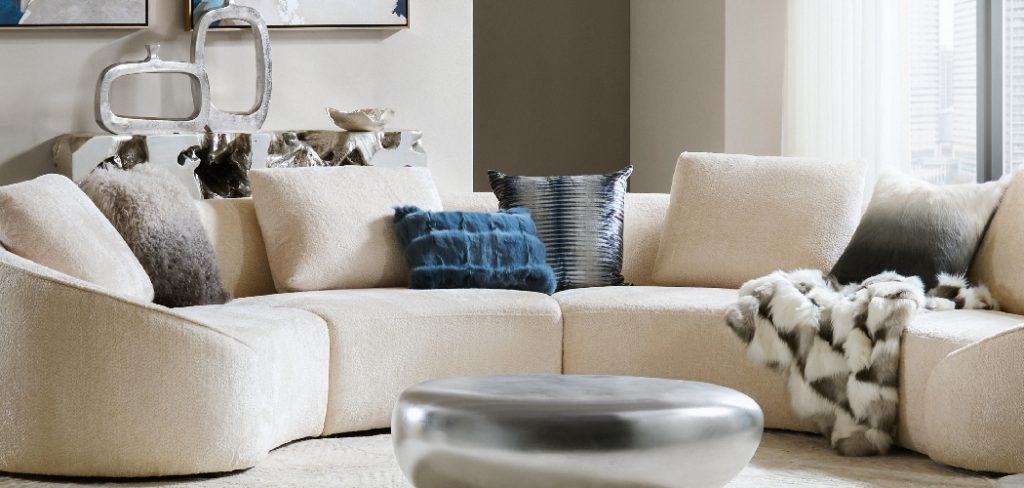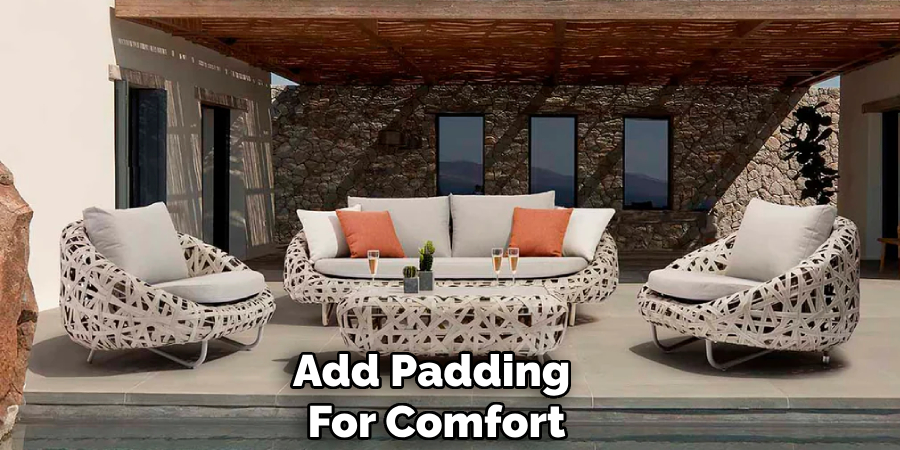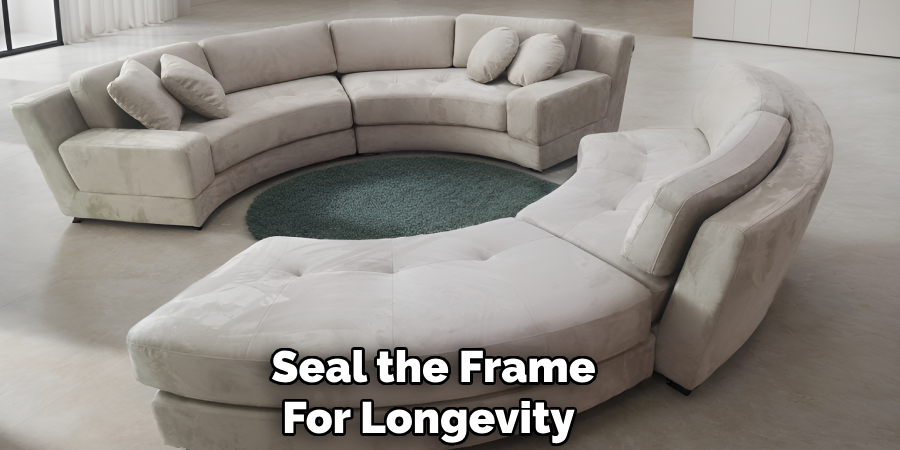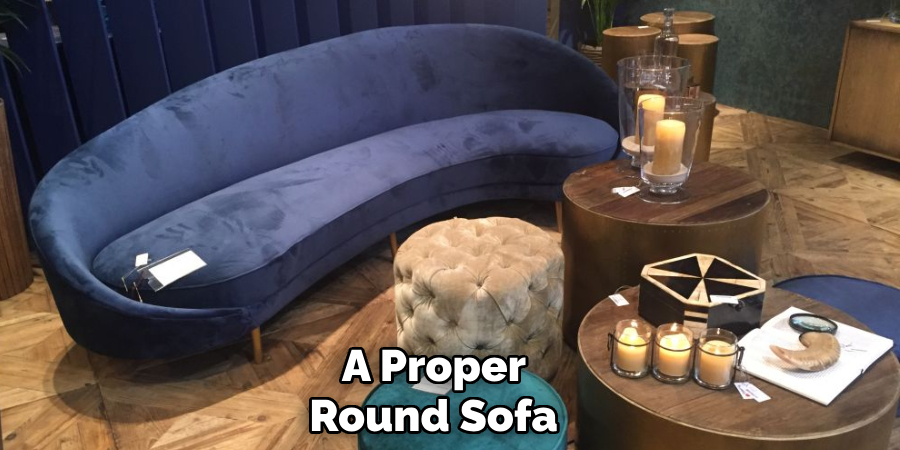Creating your own round sofa can be a rewarding and creative project that adds a unique touch to your living space. Not only does a round sofa offer a stylish and modern aesthetic, but it also provides a comfortable seating arrangement for socializing or relaxing.

This guide will walk you through the how to make a round sofa, allowing you to customize it according to your preferences and needs.
Why Make Your Own Round Sofa?
Building your own round sofa offers several advantages that go beyond simply purchasing one from a store. Firstly, it allows for complete customization, enabling you to choose the size, materials, and design that best fit your space and style preferences. This ensures that the sofa perfectly complements your interior decor while meeting your functional needs. Additionally, making a sofa yourself can be cost-effective, as you have control over the budget and material choices. It also provides a sense of accomplishment and pride, as the finished product will showcase your creativity and effort. Ultimately, crafting your own round sofa enables you to create a unique and personalized centerpiece for your living area.
Tools and Materials Needed
Before beginning the process of constructing your round sofa, it is essential to gather the necessary tools and materials. Having everything prepared ahead of time will make the project smoother and more efficient. Here’s what you’ll need:
Tools:
- Measuring tape – For precise measurements to ensure accuracy in design.
- Jigsaw or handsaw – To cut wooden components to the required shapes and sizes.
- Power drill and screws – For assembling the sofa’s frame securely.
- Staple gun – To attach upholstery fabric firmly.
- Foam cutter or electric knife – For shaping the cushions and foam.
- Screwdriver – For additional assembly and adjustments.
- Sander – To smooth any rough edges on the wooden surfaces.
- Scissors – For cutting fabric and other soft materials.
Materials:
- Plywood or hardwood – For constructing the frame of the sofa.
- Foam cushions – To provide a comfortable seating surface.
- Upholstery fabric – Choose a durable and stylish material for covering the sofa.
- Batting – For added softness and to smooth out the foam edges before upholstering.
- Wood screws – To secure the frame components together.
- Adhesive or spray glue – For attaching foam to the sofa base if needed.
- Paint or stain (optional) – To customize the wooden frame for a polished look.
- Legs or a base (optional) – To elevate the sofa off the ground for additional style and function.
Having these tools and materials ready will set the foundation for successfully crafting your custom round sofa. Be sure to double-check your list and select high-quality components to ensure a durable and beautiful final product.
10 Methods on How to Make a Round Sofa
1. Sketch Your Design and Take Accurate Measurements
Every great project starts with a plan! Begin by sketching out your round sofa design. Consider the size, height, and shape that will best suit your room. An accurate sketch not only makes the execution easier but helps you avoid costly mistakes.
Tip: Use a compass or circular template to achieve proportionate curves and shapes. Once your sketch is complete, measure the available space in your room carefully to ensure the sofa fits perfectly.

2. Use Plywood for the Base Frame
The base of a round sofa is its foundation, so it needs to be sturdy. Plywood is an excellent choice due to its durability and flexibility. Cut the plywood into circular layers using a jigsaw or similar tool, stacking and securing them together for added support.
Pro Tip: Sand the edges to avoid splinters and achieve a smooth finish before assembling the frame.
3. Create a Curved Frame with Flexible MDF
To achieve the round shape of the sofa’s body, use flexible MDF (Medium-Density Fiberboard). It’s pliable enough to bend into a curve while retaining stability. Secure the MDF to the plywood base using screws or wood glue.
Example: Furniture designers often use flexible MDF for modern chair frames because of its versatility.
4. Add Padding for Comfort
Comfort is key! Use foam padding to cover the frame, ensuring all edges are properly cushioned. Opt for high-density foam for extra durability and long-lasting comfort.
Tip: Cut the foam to fit snugly around the frame. Attach the pieces using spray adhesive for a seamless look.

5. Shape the Backrest with Curved Supports
A round sofa’s backrest can set it apart. Use wooden strips or metal rods to create a curved structure that matches the sofa’s circular base. Attach the supports to the back edge of the sofa with brackets or screws.
Example: Upholstered backrests can give the sofa a plush, luxurious feel, making it a standout feature in your decor.
6. Upholster with Durable Fabric
Choosing the right fabric is essential for both aesthetics and functionality. Select a durable material like upholstery velvet, microfiber, or leather that complements your room’s decor. Stretch the fabric tightly over the foam padding and secure it using a staple gun.
Pro Tip: Look for stain-resistant and easy-to-clean fabrics if you have kids or pets.
7. Incorporate a Rotating Base
Want to take your round sofa to the next level? Add a rotating base for functionality. Swivel mechanisms are available in furniture hardware stores and can be easily attached under the sofa’s circular frame.
Bonus: A rotating sofa is perfect for open-concept spaces, allowing you to shift between different views.
8. Add Detachable Cushions for Versatility
Detachable cushions give you the flexibility to switch up the look or increase comfort. Use smaller foam pieces for the cushions and cover them with coordinating fabric. Consider patterns or accent colors to enhance the sofa’s visual appeal.
Example: Many modular sofas come with detachable cushions to make cleaning and maintenance easier.
9. Install Sturdy Legs or Skirt it Down
For a sleek and modern look, add sturdy metal or wooden legs to elevate your sofa. Alternatively, you can omit legs and include a fabric skirt around the base for a contemporary yet grounded look.
Tip: Ensure the legs are evenly spaced and stable to avoid tipping or wobbling.
10. Seal the Frame for Longevity
Extend the life of your sofa by sealing the frame with wood varnish or paint before the foam is applied. This helps protect the material from moisture and wear, making your masterpiece more durable over time.
Pro Tip: Choose non-toxic varnishes or paints for a safer and more eco-friendly build.

Things to Consider When Making a Round Sofa
When embarking on the project of making a round sofa, there are several key factors to keep in mind to ensure a successful and satisfying result. These considerations will help you plan effectively and avoid potential challenges:
Space and Dimensions
Assess the space where the sofa will be placed and determine the appropriate size. A round sofa typically requires more space than traditional rectangular designs, so ensure it fits comfortably without overcrowding the area. Measure carefully and account for any additional space needed for movement or other furniture.
Comfort and Functionality
Think about the primary use of the sofa. Will it be a centerpiece for social gatherings or a cozy spot for relaxation? This will affect your choice of materials, cushion density, and upholstery fabric. Prioritize comfort by selecting high-quality foam and ergonomic design elements.
Aesthetic Style
Consider how the sofa will align with the overall theme of your interior decor. Choose materials, fabrics, and colors that complement the existing furniture and color palette in your room. Decide whether you want the sofa to blend in or stand out as a bold statement piece.
Skill Level and Tools
Be honest about your DIY skill level and familiarity with the required tools. Some parts of the construction process, such as cutting wood or upholstering, might require specific skills or experience. Don’t hesitate to seek guidance or consult video tutorials if you are new to certain tasks.
Budget
Establish a budget for the project and keep track of your expenses. While building a sofa yourself can save money compared to purchasing one, costs for high-quality materials and tools can add up. Prioritize essential components to stay within your financial limits.
Durability and Maintenance
Ensure the materials you select are durable and can withstand daily use. Opt for stain-resistant or easy-to-clean upholstery fabrics, particularly if the sofa will be in a high-traffic area or used by children and pets. Additionally, consider designs that allow for easy maintenance or repairs.

Conclusion
Building a round sofa from scratch is a rewarding project that combines creativity, craftsmanship, and practicality. By following these ten methods, you can design a stunning and functional piece of furniture that reflects your personal style and enhances your living space. While the process requires patience, attention to detail, and quality materials, the end result is a one-of-a-kind sofa that you can take pride in. Thanks for reading our blog post on how to make a round sofa! We hope you found it helpful and informative.
Huston Douthit is a distinguished figure in the world of furniture design, with a decade of expertise creating innovative and sustainable furniture solutions. His professional focus lies in merging traditional craftsmanship with modern manufacturing techniques, fostering designs that are both practical and environmentally conscious. As the author of Fruniturix, Huston delves into the art and science of furniture-making, inspiring artisans and industry professionals alike.
Education
- RMIT University (Melbourne, Australia)
Associate Degree in Design (Furniture)- Focus on sustainable design, industry-driven projects, and practical craftsmanship.
- Gained hands-on experience with traditional and digital manufacturing tools, such as CAD and CNC software.
- Nottingham Trent University (United Kingdom)
Bachelor’s in Furniture and Product Design (Honors)- Specialized in product design with a focus on blending creativity with production techniques.
- Participated in industry projects, working with companies like John Lewis and Vitsoe to gain real-world insights.
Publications and Impact
In Fruniturix, Huston shares his insights on furniture design processes, materials, and strategies for efficient production. His writing bridges the gap between artisan knowledge and modern industry needs, making it a must-read for both budding designers and seasoned professionals.


